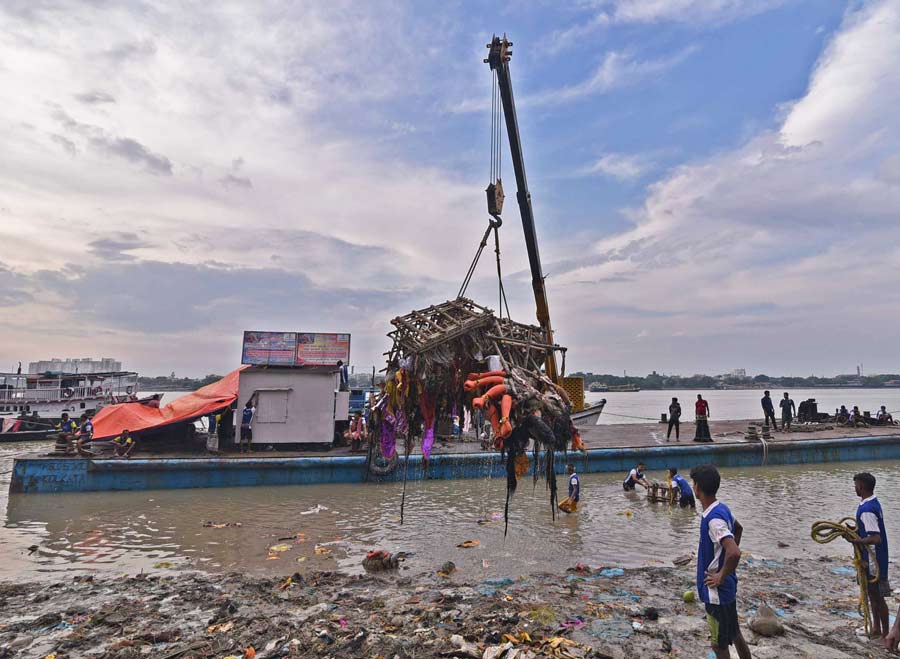The rush for immersion at Baje Kadamtala Ghat (Babughat) on Dashami peaked during low tide, resulting in the process getting halted for around an hour and a rise in the pollution of the river as immersed idols got stuck in mud, environment activists said.
According to Kolkata Municipal Corporation (KMC) sources, nearly two-thirds of the Durga idols in the city — 2,795 out of the 4,200-odd — were immersed on Dashami (Tuesday), adding to the immersion woes.
“We are waiting here for close to two hours to immerse our idols as there is not much water left in the immersion zone. There is not enough water to immerse our massive ekchala (single-framed) idol,” Mithun Hazra, one of the organisers of the puja at Rani Rashmoni’s house in Janbazar, told The Telegraph on Tuesday evening.
The organisers of several other pujas, especially those that worshipped big idols, faced similar problems during the period as the part of the river that adjoins the immersion bank was chock-a-block with immersed idols, many of which were stuck in mud.
“Low tide is creating a major problem despite all our efforts and the infrastructure that have been put in place,” said Debasish Kumar, the mayoral council member in the KMC who is overseeing the immersion process.
“Low tide is a perennial problem for immersion. Unless the immersed idols are lifted quickly, which can be done by the labourers engaged in immersion, this problem will continue. And this also results in a rise in the pollution of the river,” said environment activist Subhas Datta, whose petition a few years ago prompted the high court to issue an order to streamline the immersion process and reduce its impact on the environment.
“Idols getting stuck in the mud come in the way of their swift disposal. And longer an idol remains in the water, the more is the pollution it causes as the paint gets mixed with the water,” said an environmentalist.
The Telegraph tracked immersions for close to three hours on Tuesday and found some deficiencies
Barge
A barge fitted with a crane was deployed on the river at Baje Kadamtala Ghat to quicken the process by lifting immersed idols and depositing them on the bank.
But KMC officials said the barge was often a hindrance because it was significantly narrowing down the immersion space, especially during low tide.
“The barge may be kept slightly away so that the puja organisers get more space to immerse their idols,” said a KMC official.
“If the barge is moved away from bank, the crane may not be able to transfer the immersed idols to the bank. To overcome the problem, another barge can be deployed where the immersed idols will be transferred by the crane. The next morning the idols can be shifted to the bank for disposal.”
Time management
There seemed to be no coordination regarding the timings of the immersions. While there were only a few immersions during the day, the process peaked in the evening.
“Immersion in Kolkata, like what is done during the Jagaddhatri immersion in Chandernagore, needs to be coordinated. The tidal timings need to be factored in, among other things. Immersion should be avoided during the peak of low tide,” an expert said.
Utilisation of ghats
On Dashami, the idols from 2,417 pujas were immersed at 16 ghats along the Hooghly. Around half the idols — from 1,164 pujas — were only immersed at two ghats — Baje Kadamtala Ghat and Gwalior Ghat.
The other ghats were underutilised.
Doi Ghat received less than one-tenth of the idols immersed at Gwalior Ghat. Nimtala Ghat, second to Baje Kadamtala Ghat in terms of infrastructure,
saw the immersion of only 223 idols.
